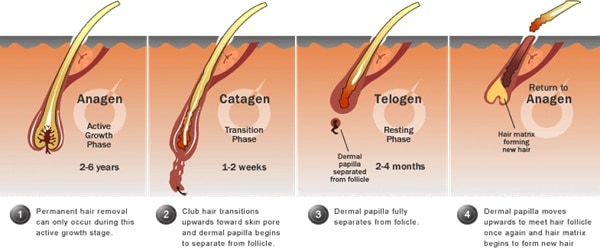Types of hair removal (not all-inclusive list)
Shaving: (cheap, easy, quick, duration 1-3 days)
Cutting the hair shaft at skin level with a sharp razor. The easiest method we rely on, and one of the cheapest, is also one that can leave our skin bumpy, stubbly and even bloody. When hair is cut at an angle it may tend to grow inward and cause “ingrown hairs” especially if curly in nature. This may cause inflamed and bumpy skin (infection) that may not resolve until hair is removed.
Depilatory creams: (more expensive than shaving, easy, quick, 1-2 weeks duration)
This technique uses chemicals that dissolve the hair shaft to skin level or a little below. Less likely to get ingrown hairs.
Just make sure to read labels and follow instructions very carefully, and to test the cream on a small patch of skin on your arm or leg to check if you’re allergic and before trying it on more sensitive areas. Depilatory creams dissolve hair in minutes, but they tend to smell like wet dog mixed with gasoline.
Waxing: ($, painful, duration is like depilatory creams)
Waxing involves applying hot or cold wax to an area and removing the wax, together with the body hair, with a strip of cloth. This breaks the hair shaft at skin level or below. You can do it on your legs, underarms, bikini area, eyebrows, and upper lip – but it’s best left to the professionals. If you’re a seasoned “waxer” and know what to expect in terms of pain and aftercare, ready-to-use wax strips can be locally purchased and utilized as DIY.
Sugaring: ($, can be DIY, similar duration to waxing)
Sugaring is like waxing, but the method uses sugar mixed with a paste or gel instead of wax. It’s a traditional hair-removal method popular in the Middle East. Recommend having it professionally done if it’s your first time to try it out. Reportedly less painful.
Threading: (cheap, quick, painful, longer duration than shaving)
Threading involves twisting a piece of thread together (hence, the name) to trap hair in the area where the thread intersects. By doing this, each hair is pulled out from the root, like tweezing or waxing. Small areas of the body are best for threading, like your eyebrows or upper lip. Results like waxing but for areas sensitive to waxing or creams. Threading is best done by a professional, especially if you’re getting it done on your eyebrows for quality shaping. Usually a cooling gel is applied afterwards to reduce redness and swelling.
Tweezing: (cheap, easy, quick, painful, similar duration to waxing)
Plucking hair with tweezers causes hair shaft breakage and is usually used in fine sensitive areas, DIY or professionally performed. Because tweezing involves removing hair one by one, this won’t work so well on large areas. Tweezing would be best for removing strays post-shave or wax. Attempt to tweeze in the direction of the hair growth.
Epilation: (special equipment, painful, similar duration to waxing)
Epilation is like high-tech tweezing. An epilator has a series of small tweezer heads on a spinning wheel and plucks out your hair from the root as you roll it over your skin. If this sounds painful its because it usually is.
Eflornithine hydrochloride cream (Vaniqa): ($$, possible side effect, long duration hair follicle growth deterrent)
Not an exfoliant that dissolves the hair shaft but reduces hair growth by enzymatic blockage. Women who feel they have been plagued by little chin hairs or thick facial hair can now benefit from this effective, but costly, prescription product. After approximately two months of twice daily use, the cream slows down hair growth.
Electrolysis: ($$, time consuming, less painful, permanent hair follicle eradication)
Usually performed by a professional who places a tiny needle with an electric current in the hair follicle. There are two primary hair removal methods with electrolysis: galvanic and thermolytic.
- Galvanic hair removal chemically destroys the hair follicle.
- Thermolytic removal uses heat to destroy the follicle.
In either case be sure to find a professional who is highly trained and knowledgeable. You can get electrolysis on any part of the body. Electrolysis is a permanent way to remove hair. That said it is possible to see hair growth in a region previously treated. The secondary growth you see will not be the same hair that has been treated. It takes anywhere from three to ten weeks for some hair to grow, and a percentage of hairs in a given area can lay dormant under the skin.
Important Note: Permanent hair removal applies to follicle damage of active growth hair unit. Because hair can be in one of four growth stages only about 25-30% of any given hair shaft seen at skin surface is amenable to follicular damage. After spending the time and energy of electrolysis on a given area it is sometimes frustrating to find hair growth returning weeks or months later. These represent hair shaft/follicles that were not seen or were missed by prior treatments.

Between starting to grow and falling out years later, each hair passes through four stages: anagen, catagen, telogen and exogen. Every hair can be at a different stage of the growth cycle at any given time.
Anagen (Growing Phase): The growing phase lasts 2-7 years and determines the length of our hair. Only phase amenable to hair follicle eradication.
Follicles in the stages below are not believed to be amenable to eradication with any techniques
Catagen (Transition Phase): This is the transitional stage that lasts about 10 days. The hair follicle shrinks and detaches from the dermal papilla.
Telogen (Resting Phase): This is the resting phase which lasts around three months. Around 10-15 percent of hairs are in this phase. While the old hair is resting, a new hair begins the growth phase.
Exogen (New Hair Phase): This is part of the resting phase where the old hair sheds and a new hair continues to grow. Approximately 50 to 150 hairs can fall out daily, this is normal hair shedding.
Laser Hair-removal: ($$$, certain types are painless, long term hair growth eradication)
Laser/IPL hair-removal destroys the hair follicle using light energy. Heat from the laser/IPL source is absorbed by the hair’s dark pigment, this energy then kills the follicle cells permanently and this technique can be used on any part of the body.
This is best used for anyone who’s sick of the maintenance, time or pain tolerance the hair-removal methods above require. It’s not cheap, nor is it quick. Due to the growth phases discussed above only a certain percentage of the hair complexes are amenable to destruction at a given time, so a few sessions may be recommended for better results.
This hair removal option damages the hair follicle to minimize future hair growth. The light energy heats the pigment (melanin) in the hair follicle and this thermal energy can damage the follicle to the point of eradication. The pigment is also present in the hair shaft. This means that if a hair shaft is present (not shaven prior to treatment) then this hair shaft can heat up at time of treatment and this can cause skin irritation or burning. This means that pre-treatment shaving is important.
-Pain free Procedure: This mechanism is dependent on the energy setting and light pulse duration (IPL) so pre-testing is a must. If the energy setting is too low, then the energy only damages the follicle but does not eradicate. Energy setting too high will cause pain and skin damage to surface skin in the form of a burn than can blister. The “snapping” pain associated with older laser techniques and devices using the wrong wave lengths for the determined skin type is no longer a common issue. Even darker skin can now undergo this therapy, but specific filters for darker skin and lower energy levels are used. Several product manufacturers (Viora IPL device) now have light filters and settings for the darker skin seen in middle eastern and African American skin types (Fitzpatrick score type VI). In addition, most devices have a cooling mechanism built into the hand piece itself to minimize thermal sensation and damage to surface skin and make the procedure comfortably pain free.
-Quicker Sessions: Laser/IPL devices today usually have larger lenses so then can cover a larger area for quicker sessions. Even a larger area can be performed in less than 20 minutes time.
What are the cons?
-It’s a longer process. A session of laser hair removal on the underarms can take less than a minute, but it takes multiple sessions to see real results (anywhere between three and eight depending on the size of the area, hair type and thickness), and you generally have to wait 4-6 weeks between treatments to allow the other follicles to enter amenable growth stage.
-Skin protection or preparation may be required. Skin pigment will redirect the energy from the hair follicle towards the skin surface so beauty marks, tattoos, and permanent make up should be covered thoroughly or can be subject to significant fading by this process. This also applies to skin tanning (using UV light), spray tans and topical make up (which requires removal prior to session).
If you are in the Austin, Texas area and have questions about a tattoo that you would like removed or about laser hair removal process, contact us at (512) 953–8566 or fill out the form below. Clean Slate’s expert technicians can set up a consultation, and we can discuss your removal options.


